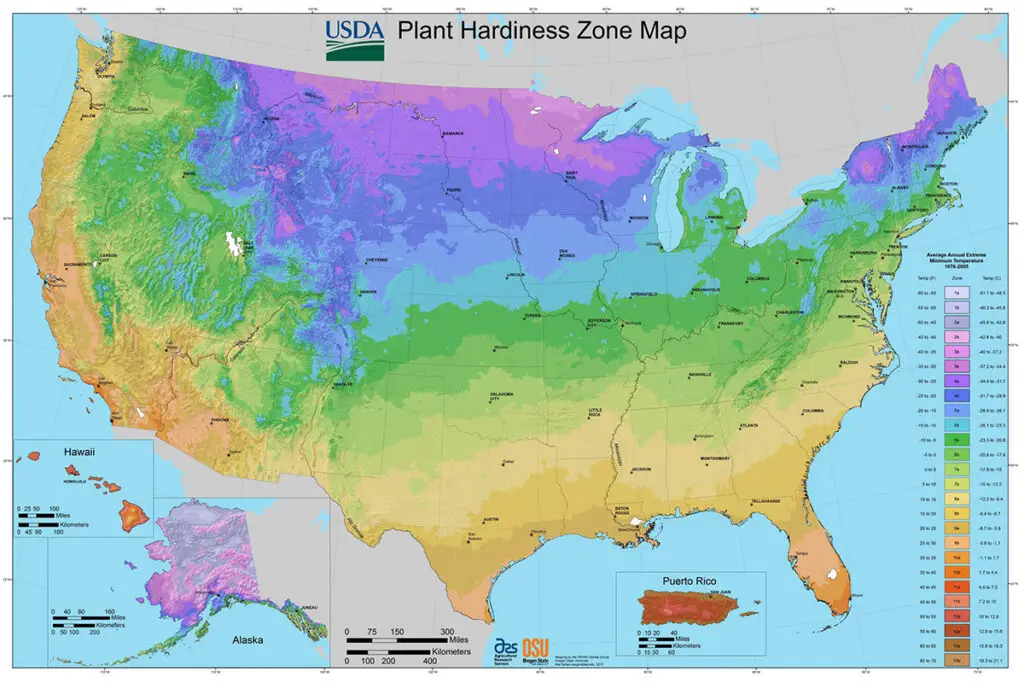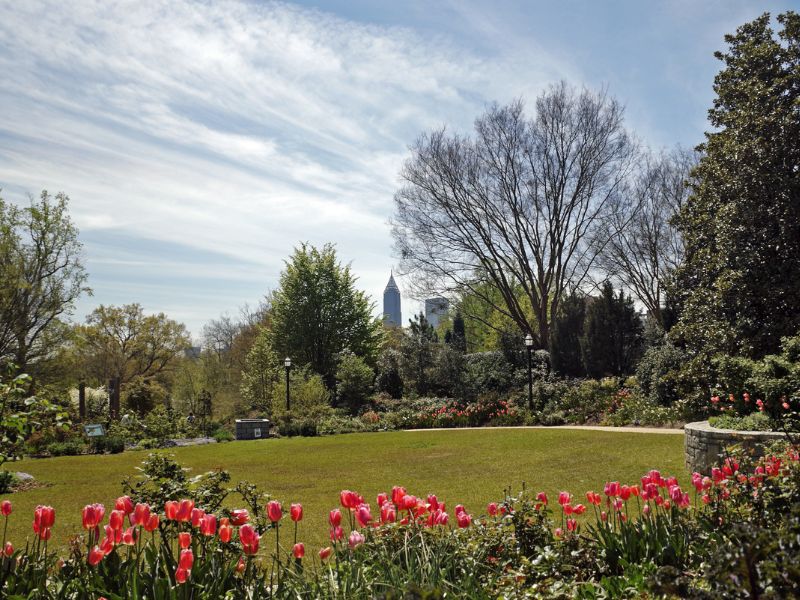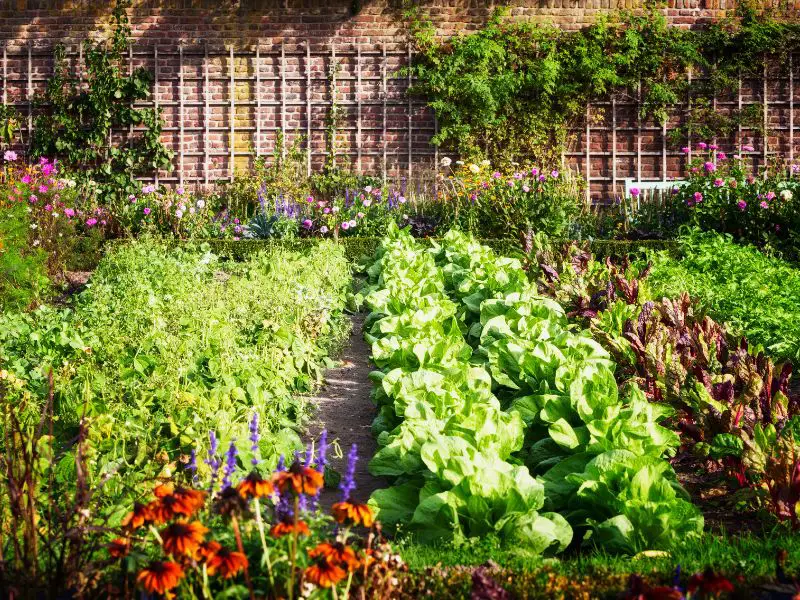Growing Zones Georgia: What To Know Before Planting
Alright, Georgia peaches, let’s get down to some good ol’ Southern gardening real talk.
If you’ve been diggin’ around in that famous red clay, you’ve likely pondered one of gardening’s greatest mysteries: “What the heck can I plant in my piece of this Peach State?”
Well, the answer, my friends, ain’t just in the soil–it’s in the zone.
Now, having tangoed with terrains from the Appalachians to the coastal plains, I’ve got the 411 on Georgia’s growing zones.
They’re a bit like nature’s playlist, each one with its own rhythm and vibe.
And, trust me, when you get your plants jamming in the right zone, that’s when the garden magic happens.
So, y’all ready to figure out your Georgia groove?
Let’s deep dive into these zones, uncover what makes each one tick, and get those green thumbs twirling!
Understanding USDA Hardiness Zones

When it comes to gardening in Georgia, familiarity with the USDA Hardiness Zone Map is essential.
This map, created by the United States Department of Agriculture (USDA), helps you determine which plants are most likely to thrive in your specific location.
Hardiness zones are determined primarily by the average annual minimum winter temperature, which varies widely throughout the state.
There are several zones for plant hardiness in Georgia, ranging from USDA Zone 6a to USDA Zone 9a.
Here’s a quick breakdown of these zones and the corresponding minimum winter temperatures:
- Zone 6a: -10°F to -5°F
- Zone 6b: -5°F to 0°F
- Zone 7a: 0°F to 5°F
- Zone 7b: 5°F to 10°F
- Zone 8a: 10°F to 15°F
- Zone 8b: 15°F to 20°F
- Zone 9a: 20°F to 25°F
By referring to an interactive version of the USDA Hardiness Zone Map, you can zoom in to a street level view, allowing you to pinpoint your specific location and associated zone.
This is a vital step in selecting the appropriate plants for your garden, as it ensures optimal growth and longevity.
It is important to keep in mind that hardiness zones are not the only factor to consider when choosing plants for your garden.
Soil type, sunlight exposure, and moisture levels also play a crucial role in determining a plant’s overall success.
Moreover, temperatures have been gradually increasing over the years, leading to periodic updates in the USDA Hardiness Zone Map.
Therefore, it is essential to keep yourself informed on these updates and make adjustments in your plant selection accordingly.
Georgia’s Hardiness Zones

When planning your garden in Georgia, it’s essential to know the hardiness zones in the state.
These zones, determined by the USDA, are based on average annual minimum temperatures, which helps you select the right plants for your area.
In Georgia, hardiness zones range from 6a to 9a.
The state is divided into four primary zones: 6a, 7a, 8a, and 8b.
In the northern parts, such as the Blue Ridge Mountains area, you will find Zone 6a, with minimum temperatures between -10°F to -5°F.
As you move south, the zones progressively get warmer.
Zone 7a covers a significant portion of the state, including the Atlanta metro area. In this zone, minimum temperatures range from 0°F to 5°F. A wide variety of plants can thrive in this temperate climate, such as azaleas and dogwoods.
Zone 8a spreads throughout central Georgia and extends to the coast. Here, the minimum temperatures are slightly warmer, between 10°F to 15°F. Some fruit trees, like peaches and plums, flourish in this zone.
The southern regions of Georgia, including coastal areas like Savannah, fall under Zone 8b. With milder minimum temperatures, between 15°F and 20°F, it is perfect for growing citrus fruits and camellias.
To find the specific hardiness zone for your location, refer to a Georgia zone map.
Checking online resources like Plantmaps or Walter Reeves’ website can provide detailed information for your city or county.
Key Georgia Cities and Their Zones

Northern Georgia
In Northern Georgia, cities like Atlanta and Athens experience relatively cooler temperatures compared to other parts of the state.
Atlanta falls within USDA hardiness Zone 7b, while Athens is in Zone 8a.
This means that plants that can thrive in these locations should be able to withstand minimum temperatures of 5 to 15°F (-15 to -9.4°C) for Zone 7b, and 10 to 15°F (-12.2 to -9.4°C) for Zone 8a.
When planning your garden in these areas, you can consider the following popular plants:
- Azaleas
- Rhododendrons
- Boxwood
Central Georgia
As you move towards Central Georgia, cities like Macon experience slightly warmer temperatures, with the city falling within USDA hardiness Zone 8a.
This means that the plants suitable for this area should be able to handle minimum temperatures between 10 to 15°F (-12.2 to -9.4°C).
Some suitable plants for Central Georgia include:
- Crepe Myrtles
- Camellias
- Dogwoods
Southern Georgia
In Southern Georgia, cities like Albany and Brunswick have a warmer climate compared to the rest of the state.
Albany is located within USDA hardiness Zone 8b, while Brunswick falls within Zone 9a.
This means that plants in Albany should be able to handle minimum temperatures of 15 to 20°F (-9.4 to -6.7°C), whereas plants in Brunswick should withstand minimum temperatures between 20 to 25°F (-6.6 to -3.9°C).
Some popular plants for Southern Georgia include:
- Southern Magnolias
- Palms
- Oleanders
Keep these hardiness zones and suitable plants in mind while planning your garden in Georgia.
Remember to choose plants that can thrive in your specific location’s climate, ensuring a healthy and flourishing garden.
When to Plant in Georgia

In Georgia, the two major planting periods for your garden are spring (March to May) and fall (mid-July to September).
In spring, you can expect to harvest your plants in June and July, while fall plantings will typically be ready for harvest from October to December.
As you plan your garden, consider the average frost dates in Georgia.
Knowing your first and last frost dates will help you start your vegetable seeds at the right time.
Georgia is in USDA plant hardiness zones 6-9, so depending on your exact location, these dates may vary slightly.
For a successful spring garden, begin planting cool-season vegetables like broccoli, cauliflower, and turnips early in the season.
These plants can handle the cooler temperatures and will provide a bountiful harvest as the weather warms up.
On the other hand, when planning a fall garden, focus on winter vegetables that thrive in Georgia’s growing zones.
These include rutabaga, onions, spinach, and more.
Starting these plants in late summer will allow them to grow and mature before the colder temperatures set in.
Keep in mind that not all plants have the same growing requirements, so it’s essential to check the specific planting dates for each vegetable, herb, or fruit you want to grow.
By doing so, you’ll ensure that you give your plants the best chance for a successful growing season, providing you with a plentiful harvest.
Remember, planning and timing are crucial for a successful garden in Georgia.
Take advantage of the spring and fall planting periods to maximize your harvest and enjoy the fruits (and vegetables) of your labor throughout the year.
Hardiness Zones and Planting

When it comes to growing plants in Georgia, it’s essential to know the hardiness zones for your region.
These zones are determined by the USDA plant hardiness zone map, which takes into account the average lowest minimum temperature at a location.
Georgia’s hardiness zones range from USDA Zone 6a to USDA Zone 9a.
Knowing your specific hardiness zone will help you determine which plants are best suited to grow in your area.
This information is crucial for the success of your garden, as it ensures that you’re choosing plants that can thrive in your region’s climate conditions.
For example, if you live in a USDA Zone 7a area, you may want to consider planting perennials like peonies, hostas, and daylilies, which are well-suited for that zone.
On the other hand, if you’re in USDA Zone 8b, you might have better success with plants like azaleas, hydrangeas, and chaste tree.
Keep in mind that your hardiness zone is just one factor to consider when selecting plants to grow.
Consider other aspects like soil type, sunlight exposure, and water requirements for optimal growth.
It’s also a good idea to consult local garden centers or horticulture experts for advice on the best plants for your specific location and conditions.
To find your Georgia USDA hardiness zone, consult the interactive map provided on the UGA or Plantmaps websites.
Once you’ve determined your zone, use it as a guideline for selecting the right plants to nurture in your garden.
By choosing the appropriate plants for your hardiness zone, you can increase the likelihood of a successful and bountiful garden.
Specific Towns’ Hardiness Zones
In this section, we’ll discuss the hardiness zones of specific towns in Georgia, to give you a better understanding of the planting conditions in these areas.
We have divided the list of towns into two sub-sections: A-L and M-Z.
A-L
- Acworth, Alpharetta, and Athens: These towns are located in the northern part of Georgia and fall under USDA hardiness zone 7b. This means that the average annual low temperature ranges between 5°F to 10°F.
- Adel, Allenhurst, Alma, Americus, and Arnoldsville: Situated in the southern part of the state, these towns have a slightly warmer climate, sitting in USDA hardiness zone 8a. The average annual low temperature ranges from 10°F to 15°F.
- Alto and Ashburn: These towns are located in central Georgia and are classified as USDA hardiness zone 8b. The average annual low temperature ranges between 15°F to 20°F.
- Augusta, Avalon, and Baconton: These towns have a warmer climate compared to other towns in the state, falling in USDA hardiness zone 8b. Their average annual low temperature ranges from 15°F to 20°F.
M-Z
- Madison: This town is located in the northeastern part of Georgia and falls under USDA hardiness zone 8a. The average annual low temperature ranges between 10°F to 15°F.
Knowing the hardiness zones of these specific towns can help you make better decisions when choosing the right plants for your garden or landscape.
Always remember to check the appropriate hardiness zone before starting your planting journey.
Considerations for Garden Planning in Georgia
When planning your garden in Georgia, it’s essential to take into account the state’s climate and plant hardiness zones.
Georgia’s planting zones range from 6a to 9a, meaning different areas of the state experience varying climate conditions.
Knowing your specific growing zone will help you select plants that will thrive in your area.
First and foremost, choose plants that are suited to your local planting zone.
Plants from reputable nurseries will often have their appropriate zones clearly marked.
You can plant any vegetation that falls within your zone or lower, as they will be more likely to survive the winter in your region.
Next, consider the timing of your garden.
In Georgia, there are two primary planting periods: spring (March to May) and fall (mid-July to September).
Spring plantings are typically harvested in June and July, while fall plantings are harvested from October to December.
Be sure to select vegetables and flowers that will grow well during your chosen planting period.
When planning your garden layout, take into account the importance of soil preparation.
Properly preparing the soil with lime and fertilizer, as needed, will improve the overall health of your garden and ensure a successful harvest.
Additionally, using mulch can help conserve soil moisture and suppress weed growth.
Finally, pay attention to the maintenance of your garden.
Regularly water your plants, especially during the hot summer months, and keep an eye out for any potential insect or disease problems.
Employing proper garden cultivation techniques can contribute to a thriving and beautiful outdoor space.
Difference between USDA Hardiness Zones
The USDA Hardiness Zones are an essential tool for gardeners and growers in Georgia to understand which plants are most likely to thrive in their area.
These zones are based on the average annual minimum winter temperature and are divided into 10-degree Fahrenheit ranges.
In Georgia, you can find a range of hardiness zones, from 6a to 9a.
Understanding the differences between these zones is crucial for selecting the right plants for your garden and ensuring their survival during the colder months.
Zone 6a has an average annual minimum temperature of -10°F to -5°F. Majority of Georgia does not fall in this zone, but you can find patches in the northern mountains. If you live in this area, it’s essential to choose cold-hardy plants that can withstand these low temperatures. Some options include peonies, viburnum, and hostas.
Zone 7a and Zone 7b cover broad parts of North Georgia. In these zones, the minimum winter temperatures range from 0°F to 5°F for 7a and 5°F to 10°F for 7b. Plants suitable for these regions include azaleas, dogwood trees, and hydrangeas.
Zone 8a and Zone 8b are prevalent in Central and parts of South Georgia. The minimum annual temperatures in these zones are 10°F to 15°F for 8a and 15°F to 20°F for 8b. You can grow a wide variety of plants in these zones, such as camellias, crape myrtles, and magnolia trees.
Lastly, Zone 9a can be found in southeastern Georgia near the coast. This zone has an average annual minimum temperature of 20°F to 25°F. This warmer climate allows for the growth of subtropical plants, such as palm trees, citrus fruits, and gardenias.
Remember, when choosing plants, always consult the USDA Hardiness Zone map and select species that are suitable for your specific area.
This will help ensure their success and overall health in the varying climates found throughout Georgia.